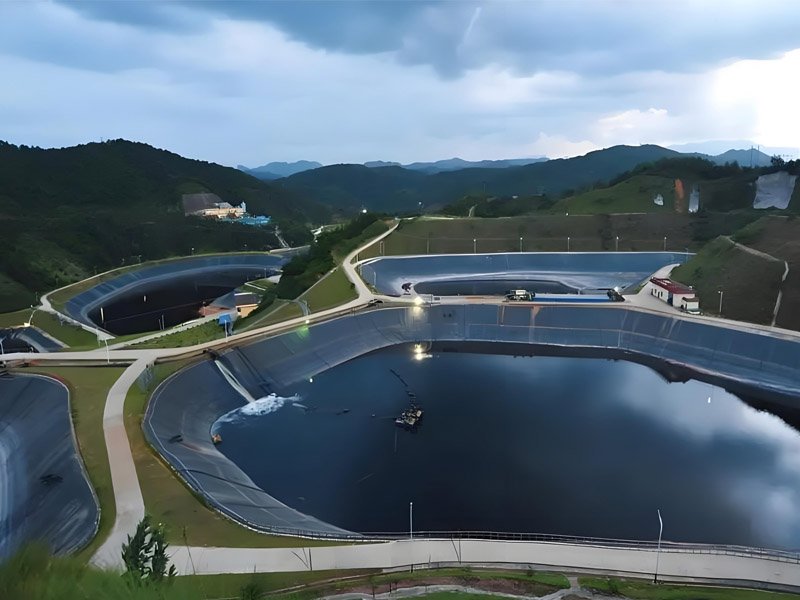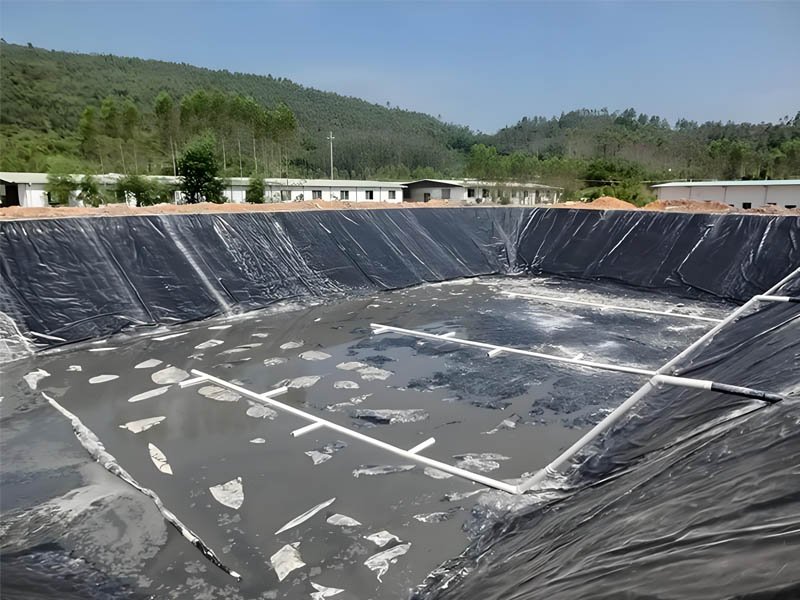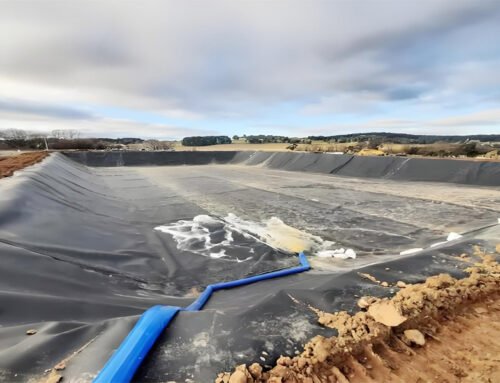Are you a fish farmer who is concerned about the health of your fish and plants? If yes, then we bet you are searching for a good pond liner. The market offers a large number of HDPE Fish Pond Liner of varying quality, price, and material. However, choosing the right GEOSINCERE Pond Liner can be overwhelming depending on your requirements. Well, no need to panic, we will provide you with a detailed guide on how to choose the right pond liner.
1. What Is A HDPE Fish Pond Liner?
A HDPE fish pond liner, or High-Density Polyethylene fish pond liner, is a type of synthetic material used to line the bottom and sides of fish ponds. This liner serves several important purposes:
- Waterproofing: It prevents water from seeping into the ground, which helps maintain the water level in the pond and reduces the need for frequent refilling.
- Durability: HDPE is known for its strength, flexibility, and resistance to punctures and tears, making it ideal for long-term use in various environmental conditions.
- Chemical Resistance: The material is resistant to many chemicals and substances that could be present in the pond environment, including aquatic treatments and fertilizers.
- Environmental Protection: By preventing water loss and contamination, the liner helps protect the surrounding environment and ensures a healthier habitat for the fish and other aquatic life.
- Ease of Installation: HDPE liners are typically easy to install, often coming in large rolls or pre-formed shapes that can be cut and fitted to the desired pond dimensions.


2. What Are Applications Of HDPE Fish Pond Liner?
HDPE (High-Density Polyethylene) fish pond liners have a wide range of applications due to their durability, flexibility, and environmental benefits. Here are some key applications:
- Residential Fish Ponds: HDPE liners are commonly used in home gardens to create decorative fish ponds. They help maintain water levels and provide a healthy environment for fish and aquatic plants.
- Commercial Fish Farms: In commercial aquaculture, HDPE liners are used to construct fish farming ponds. They ensure the containment of water, reduce seepage, and protect against contaminants, contributing to higher productivity and sustainability.
- Public Parks and Recreational Areas: Public spaces often feature HDPE-lined ponds to enhance aesthetic appeal and provide recreational fishing opportunities. The liners help manage water quality and support healthy fish populations.
- Conservation Projects: Environmental conservation projects, such as restoring wetlands or creating wildlife habitats, benefit from HDPE liners. They help prevent water loss and contamination, ensuring that ecosystems remain intact and supportive of native species.
- Agricultural Irrigation Ponds: On farms, HDPE liners are used to create irrigation ponds that supply water for crop cultivation. These liners minimize water loss through evaporation and seepage, improving water efficiency.
- Water Treatment Facilities: Some water treatment plants use HDPE liners in their reservoirs and settling ponds to contain treated water securely. The material’s resistance to chemicals and durability make it suitable for various treatment processes.
3. How To Choose Right HDPE Fish Pond Liner?
Choosing the right HDPE (High-Density Polyethylene) fish pond liner involves several important considerations to ensure it meets your specific needs and provides long-term performance. Here’s a comprehensive guide to help you make an informed decision:
3.1 HDPE Fish Pond Liner – Thickness:
- Standard Thicknesses: HDPE liners typically come in various thicknesses, ranging from 30 mil (0.76 mm) to 100 mil (2.54 mm) or more.
- Purpose-Fit: For small residential ponds, a 30-40 mil liner is enough. For larger commercial ponds, thicker liners around 60 mil or more are needed to handle greater water pressure and wear.
3.2 HDPE Fish Pond Liner – Dimensions:
- Measure Your Pond Area: Accurately measure the length, width, and depth of your pond area.
- Overlap Allowance: Ensure the liner size includes enough overlap for securing the edges, typically an additional 2-4 feet on all sides.
3.3 HDPE Fish Pond Liner – Durability and Quality:
- Material Integrity: Choose a liner made from high-quality, UV-stabilized HDPE to prevent degradation from sunlight exposure.
- Reinforcement: Consider reinforced options if your pond is in an area prone to heavy use or has sharp objects that could puncture the liner.
3.4 HDPE Fish Pond Liner – Environmental Conditions:
- Climate Suitability: Ensure the liner is suitable for your local climate. Some liners are designed to withstand extreme temperatures better than others.
- Chemical Resistance: Verify that the liner can resist chemicals commonly used in pond maintenance, such as algaecides and fertilizers.
3.5 HDPE Fish Pond Liner – Installation Ease:
- Ease of Handling: Look for liners that are easy to handle and install. Lightweight yet durable materials make the installation process smoother.
- Joining Methods: Check if the liner requires special joining methods or if it comes with pre-prepared seams to simplify installation.
3.6 HDPE Fish Pond Liner – Cost vs Value:
- Budget Considerations: Cheaper options may be tempting. High-quality liners reduce long-term costs. They need less maintenance and fewer replacements.
- Warranty: Check if the liner comes with a warranty. A longer warranty period often indicates confidence in the product’s durability and quality.
3.7 HDPE Fish Pond Liner – Supplier Reputation:
- Reviews and Recommendations: Research suppliers and read customer reviews to gauge reliability and product satisfaction.
- Customer Support: Ensure the supplier offers good customer support, including installation advice and after-sales service.
3.8 HDPE Fish Pond Liner – Specific Use Case:
- Fish Type: Different fish species have varying habitat requirements. Ensure the liner material is safe and non-toxic for the type of fish you plan to keep.
- Aesthetic Needs: If aesthetics are important, consider liners available in different colors and textures to match your landscape design.


4. What Are Steps For Installing HDPE Fish Pond Liner?
Installing an HDPE (High-Density Polyethylene) fish pond liner involves several key steps to ensure proper fit, functionality, and longevity. Here’s a detailed guide:
4.1 Site Preparation:
- Clear the Area: Remove any debris, rocks, or vegetation from the pond area.
- Level the Ground: Ensure the ground is level to avoid uneven settling of the liner.
4.2 Measure and Cut the Liner:
- Measure the Pond: Accurately measure the length, width, and depth of the pond.
- Cut the Liner: Use sharp scissors or a utility knife to cut the liner to the required size, adding extra overlap for securing the edges.
4.3 Lay Out the Liner:
- Unroll the Liner: Lay out the liner in the pond area, ensuring it covers the entire bottom and sides with sufficient overlap.
- Smooth Out Wrinkles: Smooth out any wrinkles or folds to prevent sagging or tearing later.
4.4 Secure the Edges:
- Anchor the Liner: Secure the edges of the liner using landscape anchors, staples, or rocks. Make sure the liner is taut but not overly stretched.
- Overlap and Seal: If using multiple pieces, overlap the seams by at least 12-18 inches. Use underlayment tape and adhesive to seal the seams.
4.5 Fill the Pond:
- Gradual Filling: Begin filling the pond with water gradually to allow the liner to settle evenly and prevent shifting.
- Check for Leaks: As you fill, inspect the liner for any leaks or weak spots. Repair any issues immediately using patch kits or additional tape.
4.6 Finishing Touches:
- Edge Covering: Cover exposed edges with coping stones, bricks, or other decorative materials to prevent damage and improve aesthetics.
- Planting and Landscaping: Add plants and landscaping features around the pond to blend it into your environment.
4.7 Maintenance:
- Regular Inspections: Periodically check the liner for signs of wear, punctures, or leaks.
- Clean the Pond: Maintain water quality by cleaning the pond and changing the water as needed.
5. Conclusion
In conclusion, selecting the right HDPE fish pond liner is crucial for creating a thriving and visually appealing aquatic environment. By considering factors such as liner thickness, size, durability, environmental suitability, ease of installation, cost, and supplier reputation, you can ensure that your pond will provide a safe and sustainable habitat for your fish. Investing time in researching and choosing the best liner will not only enhance the beauty and functionality of your pond but also contribute to its long-term maintenance and enjoyment.





